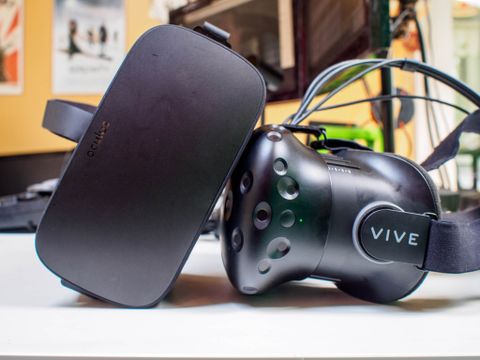Buying a desktop-class VR headset right now is a big, expensive choice. You have to have a PC capable of driving the experience before you even plug a headset in, but when you finally reach that point you'll find yourself faced with a pair of excellent choices. You can buy an Oculus Rift, the VR headset that rekindled a global interest in consuming 360-degree content with its record-shattering Kickstarter campaign. Or you can go with the HTC Vive, a VR headset with new tech developed by Valve — the champion of PC gaming as we know it today.
Choosing between these two incredibly capable headsets is no small task, and has a lot to do with knowing how you're going to want to use your VR headset before you buy it. That's not always easy, so after three months of constantly using each of these headsets we've broken the answer down into simpler choices.
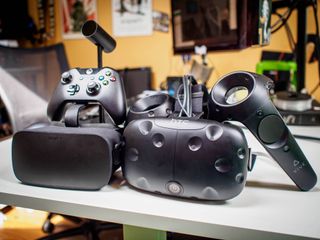
Setup
The good news is both headsets come in great big boxes. Taking these two headsets out of the box couldn't be more different, though.
Oculus Rift can be removed from its packaging and be ready to go within 20 minutes. It takes up three USB ports and an HDMI port on your computer, and once everything is connected and the software is installed, you're good to go. The Xbox Controller included in the kit starts working immediately, and there's no significant setup time. This setup is almost portable, assuming you have a monster laptop capable of powering the headset.
Setting up an HTC Vive is a little more complex. There's a pair of small black boxes that need to be installed diagonally from each other on separate sides of the space you're going to play in, each requiring their own power outlet. The headset connects to a sync box that requires a USB port, an HDMI port, and a third power outlet. Once the hardware is connected, you'll be treated to a calibration setup that involves tracing the play area by walking around with the controller out in front of you. The instructions make it all very simple, but the total time from opening the box to playing a game is upwards of 40 minutes. lightbox

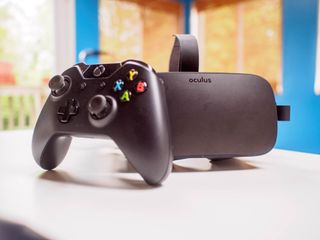
Of course, the reason HTC's setup process is so complicated is due to how you use the Vive when you play. This experience is full body motion, which means you're standing and walking around in your play space. When you lift your hands up, the controllers in each hand can be seen in the game you're playing. You can turn in any direction, walking and swinging your arms around to enjoy the game you're playing. That calibration where you walk around your room is to give a boundary to the system, and when you get close to that boundary you'll see it in your headset so you know not to run into a wall or knock over a lamp.
Out of the box, Oculus offers nothing similar to the room-scale experience you get with a Vive. In order to recreate this experience, and indeed play many of the games that take advantage of this format, you need to purchase the Oculus Touch controllers from Oculus. These will give you motion controllers and the second sensor to place on your desk and connect to your PC. With 2 sensors depth can be better portrayed, so you have a lot more room to move around. To get the full Vive experience, Oculus recommends you purchase the third sensor from them and set it up on the other side of your desk. Currently, few games require this setup in order to play.
It's important to point out how different Vive and Rift motion controllers are, once you are set up. Just about every SteamVR game supports these Vive controllers, but in many games, rapid movement can occasionally cause you to either smack the controllers together or smack yourself in the headset with a controller. The triggers are decent for shooting but not quite as refined as you may be used to on an Xbox or PlayStation. Oculus Touch is a more compact and refined set of controllers, including what Oculus calls "hand presence" so you can see your index finger and thumb move in VR. There aren't many games that support hand presence in any meaningful way, but the controllers themselves are quite nice. While there are many more games that support the Xbox controller in Oculus Rift right now, Oculus Touch is likely to quickly grow in popularity with VR game developers.
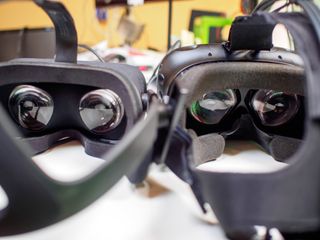
Comfort
If you're spending this much money on a VR experience, you're going to want to use it a lot. Whether that's just you using it or you passing the headset from person to person at a party, comfort is important. You need to be able to comfortably put the headset on, and you need to know you're going to be able to wear the headset for extended periods of time without discomfort.
Oculus built Rift to be super simple to put on. For most folks, you almost put the headset on like you would a baseball cap. The rigid back section lines up with the back of your head, and you pull the bulky display section down until you reach your nose. The headset is on elastic rails, so it stretches to fit over your face and then hugs your head once you let go. If you don't wear prescription glasses, this is perfect. If you do wear glasses, you'll need to put the headset on eyes first. This is considerably less comfortable, especially since the eye sockets on this headset don't leave a ton of room for glasses.
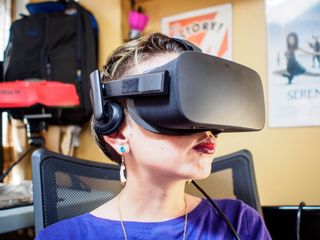
Putting a Vive on involves holding the bulky display part up to your face, pulling the strap down onto the back of your head, and tightening the large elastic straps until everything is comfortable. For the side straps, this is no big deal, but the top strap is more than a little obnoxious. The strap rests under the three-in-one data cable that runs from the top of the headset to the computer, which means it's heavy and rubbery and 100% in your way. You have to lift the cable up, adjust the headset, and pull the cable back into place. Vive is a little more 'glasses friendly' thanks to its wider eye socket opening, but the overall setup is a little tedious.
Audio is a massively important part of VR, and comfort has a big part of this as well. Oculus has headphones built in, and they lay over your ears with ease. If you want to replace these headphones with something that removes environmental noise or offers higher quality sound, there are some hurdles to jump through. Vive, on the other hand, offers a headphone jack on the headset so you can connect whichever headphones you desire. This is great when you realize the earbuds that come with the headset aren't very good and fall out easily, but it also means you have to find headphones that will comfortably rest on your ears over top of the VR headset straps.

As for comfort over time, surprisingly it's mostly a draw. When correctly fitted to your head, Vive and Rift can each be worn for several hours without pressure discomfort. Some people notice eye fatigue after several hours, and any Vive player who is actively playing a game and doesn't feel tired after a while is doing it wrong, but there's no firm breaking point for any of us who regularly wear these headsets.
Multiple users is a little different, due entirely to the material used in the padding between the headset and your face. HTC's facial padding is a lot more absorbent, which means it can quickly become gross with sweat. HTC includes an extra face pad in the box so you can swap it out quickly when one needs to be cleaned, but Oculus does not.
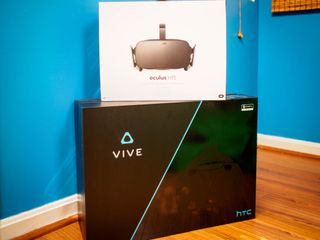
Price
When its all said and done, you're spending a lot of money on a VR headset by going with either of these options. The PC, the headset, and the games available for it all are big expenses to be considered.
You can actually play most Oculus Rift games on your HTC Vive right now.
Off the shelf, Oculus Rift costs you $420. You get the headset, two camera sensors, Xbox controller, Touch controllers and a mini remote. It's everything you need to get started, and right now the Oculus Store has well over 100 games and apps for you to experience. Most of these games are designed to be played while sitting down and looking around, making it so this new world fills your vision while you play with a controller in your hand. If you decide to upgrade to Oculus it will be another $30 for the third sensor required for room-scale gameplay.
An HTC Vive will run you $499. You get the headset, lighthouses (the two sensor boxes), two hand controllers, and everything needed to connect to the headset to your computer. This is everything you need to have room-scale VR, which means you can have a totally dedicated VR room where you walk around and enjoy every game, or you set up in your living room and pull your gear out when you want to play. Steam VR has hundreds of games available right now, including a massive Early Access section where developers are looking for player feedback to make their games better before pushing out a full retail release.
If you are willing to mess around with some third-party software, you can actually play most Oculus Rift games on your HTC Vive right now. You still need an Xbox One controller to play the games, and you have to buy the games through the Oculus Store, but it works well.
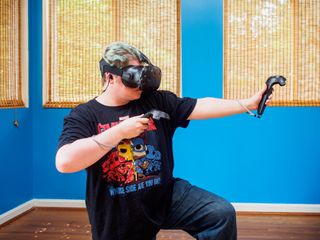
Which should you choose?
If you're looking for the best possible VR experience you can buy today, the HTC Vive is where it's at. HTC and Valve have created a wholly unique experience, and developers of every skill level have flocked to the platform. The games are vibrant and creative in ways you don't see much in traditional gaming platforms right now. These are unique, emotional experiences that are fun on Oculus Rift, but truly shine on HTC Vive.
Oculus Rift is priced competitively, and it's a fantastic overall experience. The Touch controllers are exceptional, and Oculus as a company is working hard to create unique social experiences inside VR that may one day turn out to be the killer feature everyone really wants. Oculus Rift also currently requires less hardware to run than the HTC Vive, though you lose some visual quality when you drop to the minimum system requirements.
This post was last updated in March 2018: We've updated the prices for both of the VR headsets, awesomely enough they've both gotten a lot cheaper through Amazon!
Russell is a tech nerd who chases the best of everything, from phones to game consoles to laptops and everything glowing or beeping. He's the Managing Editor of gaming content for Mobile Nations and can be found contributing to all of the Mobile Nations sites. Reach out on Twitter!
